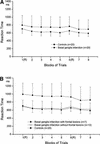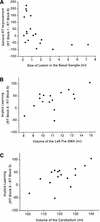The differential role of premotor frontal cortex and basal ganglia in motor sequence learning: evidence from focal basal ganglia lesions
- PMID: 12464697
- PMCID: PMC187585
- DOI: 10.1101/lm.48402
The differential role of premotor frontal cortex and basal ganglia in motor sequence learning: evidence from focal basal ganglia lesions
Abstract
There has been a growing interest in the differential role of various neural structures in implicit learning processes. The goal of our study was to clarify how focal lesions restricted to the basal ganglia interfere with different aspects of implicit visuo-motor sequence learning. A version of the Serial Reaction Time Task (SRTT) of Nissen and Bullemer using a 12-trial sequence was administered. A total of 20 subjects with focal basal ganglia lesions caused by ischemic or hemorrhagic infarction and 20 matched control subjects participated in this study. The results indicate that subjects with focal basal ganglia lesions showed unimpaired implicit learning of a 12-item motor sequence. Subjects with basal ganglia lesions, however, had more difficulties improving their general proficiency with the reaction-time task independent of sequence-specific learning. We observed a tendency toward smaller regional volumes in the cerebellum and left pre-supplementary motor area (pre-SMA) of subjects with basal ganglia lesions. Smaller cerebellar and pre-SMA volumes were related to lower implicit learning performance in the lesion group. The size of lesions in the basal ganglia was not related to sequence-specific implicit learning but had a significant influence on subjects' general proficiency for execution of the reaction-time task. We propose that implicit learning is achieved by a distributed network of cortical and subcortical structures. The basal ganglia seem to be responsible for adjusting to the general requirements of a task rather than for learning specific associations between stimuli that might be accomplished by premotor frontal areas and the cerebellum instead.
Figures




References
-
- Akritas MG, Brunner E. A unified approach to rank tests for mixed models. J Statis Plan Infer. 1997;61:249–277.
-
- Aylward EH, Anderson NB, Bylsma FW, Wagster MV, Barta PE, Sherr M, Feeney J, Davis A, Rosenblatt A, Pearlson GD, et al. Frontal lobe volume in patients with Huntington's disease. Neurology. 1998;50:252–258. - PubMed
-
- Crespo-Facorro B, Kim JJ, Andreasen NC, O'Leary DS, Wiser AK, Bailey JM, Harris G, Magnotta VA. Human frontal cortex: An MRI-based parcellation method. NeuroImage. 1999;10:500–519. - PubMed
Publication types
MeSH terms
LinkOut - more resources
Full Text Sources
Medical
